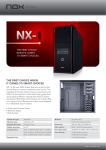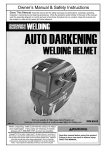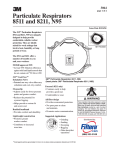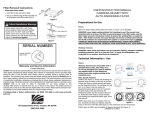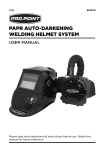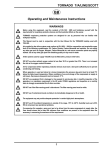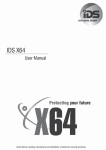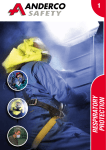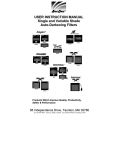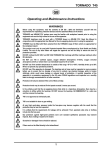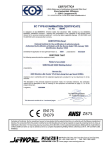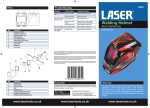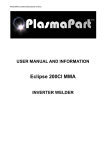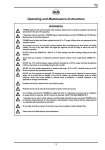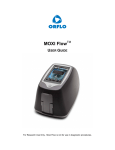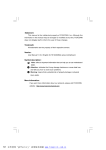Download Clean Air Flow® Manual
Transcript
Definition of Safety Signal Words per ANSI Z 535.4 WARNING Indicates a potentially hazardous situation which, if not avoided, could result in death or serious injury. C AUT ION Indicates a potentially hazardous situation which, if not avoided, may result in minor or moderate injury. It may also be used to alert against unsafe practices. Do not use this product until you have read and understood this instruction manual which is an essential part of the CLEAN AIR FLOWTM System. If the equipment is not properly assembled, connected, and used in strict conformance with this instruction manual, contaminated air could be drawn in the System, resulting in exposure, which may lead to serious bodily injury or loss of life. Use by unqualified or untrained persons, or use other than in accordance with this instruction manual, is dangerous and could expose you to serious bodily injury or loss of life. Table Of Contents 1.0 General Information 1.1 1.2 1.3 1.4 Introduction Operating Principles Respirator Approvals & Limitations Helmet & Welding Filter Approvals & Limitations 2.0 System Use 2.1 2.2 2.3 2.4 2.5 2.6 2.7 2.8 Battery Filters Blower Headtop Waist belt Pre-Operational Inspection Donning Troubleshooting 3.0 Maintenance and Storage 3.1 3.2 3.3 3.4 Record Keeping Cleaning Inspection Storage 4.0 Replacement 4.1 4.2 4.3 4.4 4.5 4.6 4.7 4.8 Battery Filter Blower Breathing Tube Faceseal Waist Belt Airduct Headgear Assembly Replacement Auto-Darkening Lens Replacement 5.0 Customer Information 5.1 Replacement Parts and Accessories 5.2 Technical Specifications 5.3 Warranty 5.4 Warranty Registration Card 5.5 Customer Service Appendix I - Respirator Approval Label Appendix II - Filter/Cartridge Approval Label TM by AIR FLOW DIAGRAM A complete Clean Air FlowTM System Includes: • A Choice of Lightweight and Durable Nylon Vision or Viper Welding Helmet or a Hard Hat Visor combination. • • • • • • • • • A Choice of Auto-Darkening Welding Lens (welding helmets only) Air-O Dynamic Airduct Headgear with Sweatband ComfaSealTM Face Seal (Vision helmet only) One HE Particulate Filter Blower Unit 8.4V Lithium-Ion Battery and Charger Breathing Tube Choice of Adjustable Belts Carrying Case (not shown) 1.0 General Information 1.1 Introduction Congratulations! You have purchased the ultimate in comfortable welding powered respiratory protection equipment manufactured in the world today. The complete CLEAN AIR FLOWTM Powered Air Purifying Respirator System is offered in four distinct lightweight headtops: Straight Bill and Reverse Bill Hard Hat Visor Combo, Vision and Viper welding helmets. The welding helmets include ArcOne’s family of electronic auto-darkening filters. (See ArcOne’s AutoDarkening Welding Helmets “User Instruction Manual,” for details on ArcOne’s welding helmets and auto-darkening lenses). The Hard Hats allow faceshield and welding helmets to be used as accessories on the headtops, opening up a large range of options (see approval label) to the user. The Clean Air FlowTM Powered Air Purifying Respirator System blows a supply of filtered air over the welder’s face, creating a protective positive pressure inside the face collar, that keeps out harmful gases, vapors and particulates, and offers additional comfort when working conditions are hot and humid. Our goal is to make your demanding job comfortable and safe. The Clean Air FlowTM system is not only engineered for safety and functionality but also for lightweight comfort. You can wear the Clean Air FlowTM system all day with no worry of fatigue or respiratory stress. To assure your complete satisfaction with the Clean Air FlowTM system, we ask that you read these user and safety instructions thoroughly before using the system. PLEASE, also take the time to read the Auto-Darkening Welding Helmets- “User Instruction Manual” (if applicable) which is enclosed. The complete Clean Air FlowTM System has been engineered for: TOTAL PROTECTION to the user - (1) Clean Air FlowTM POWERED AIR PURIFYING RESPIRATOR - Filters the air that a user breaths into his or her lungs. (2) ARCONE’S AUTO-DARKENING LENS - Protects the eyes, and prevents against neck injuries (3) VIPER and VISION SERIES WELDING HELMETS - Ergonomically designed to protect the face, head, and neck areas during welding. 1.2 Operating Principals This Clean Air Flow TM system is used in a welding environment where protection is required against harmful particles and mist. The Clean Air Flow TM , in conjunction with ArcOne’s Auto Darkening Lens and Viper and Vision welding helmets eliminate much of the wasted motion and discomfort associated with welding. You will receive a constant flow of fresh air, which will allow you to comfortably remain safely in your work environment for a longer period of time, and is of particular benefit where working conditions are hot or humid. The Clean Air FlowTM blower unit supplies an over capacity of 170 Liters per minute of filtered air to the headtop, and allows the user to breathe without having to overcome the resistance of the filter. Considering that an adult person requires an average of 45 liters of air per minute, the over capacity ensures a slight overpressure and thus a high degree of protection. The Clean Air FlowTM system is powered by a rechargeable Lithium-Ion battery, which is encased in durable lightweight plastic. The battery securely attaches to the blower unit. The battery provides protection for an 8 hour shift. The battery is delivered in the uncharged state; the charging time for a fully discharged battery is 8 hours. (See Section 2.1 Battery Charging) The Clean Air FlowTM blower unit should be fitted with a filter appropriate to the application and selected by a competent person with a full knowledge of respiratory hazards, and their concentrations that are applicable in the workplace. To ensure adequate protection, it is essential that the blower unit is correctly configured and that the correct filter is used. (See Section 2.2 Filters) If there is any doubt of final determination of respirator applicability and filter selection, it must be made by an on-site safety specialist or industrial hygienist. (or contact the National Institute of Occupational Safety and Health). 1.3 Respirator Approvals & Limitations The Clean Air FlowTM System as described in this instruction manual has been approved by the following agencies • NIOSH 42 CFR Part 84 (USA) (See enclosed Appendices) 1. Improper respirator use may cause injury or death. Improper use may also cause certain life-threatening delayed lung diseases. Regulations require that the employer provide training to the user on proper use, maintenance and limitations of the Clean Air FlowTM PAPR system. 2. Each person using these respirators must first read and understand this entire instruction manual. Before using the Clean Air FlowTM PAPR system, be sure your employer has determined that airborne contaminant concentrations do not exceed those allowed by applicable OSHA, MSHA, EPA, NIOSH or ACGIH regulations for Powered Air Purifying Respirators. Federal law requires that your employer measure and monitor airborne contaminant levels in the work area. 3. Failure to use components and replacement parts approved by NIOSH for use with this respirator system voids NIOSH approval of the entire respirator, invalidates all ARCONE® warranties, and may cause death, lung disease or exposure to other hazardous or life-threatening conditions. 4. Inspect all components of the Clean Air FlowTM PAPR system during cleaning and before and after each use for signs of wear, tear or damage that might reduce the degree of protection originally provided. Immediately replace worn or damaged components with ARCONE’S Clean Air FlowTM PAPR components approved by NIOSH for use with this respiratory system. 5. DO NOT use the Clean Air FlowTM PAPR system in inadequately ventilated areas, where oxygen is less than 19.5%, or in confined spaces such as tanks, small rooms, tunnels or vessels unless the confined space is well-ventilated and contaminant concentrations are below the recommendations for this system. The procedures for confined space entry, operation and exit are defined in applicable regulations and standards, including 29 CFR 1910.146. Cautions and Limitations (refer to the enclosed Approval Labels) • Not for use in atmospheres containing less that 19.5 percent oxygen. • Not for use in atmospheres immediately dangerous to life or health. • Do not exceed maximum use concentrations established by regulatory standards. • Do not use powered air-purifying respirators if airflow is less than six cfm (170 lpm). • Follow established cartridge and canister change schedules or observe ESLI to ensure that cartridges and canisters are replaced before breakthrough occurs. • Contains electrical parts which have not been evaluated as an ignition source in flammable or explosive atmospheres by MSHA / NIOSH. • Failure to properly use and maintain this product could result in injury or death. • Follow the User’s Instructions for changing filters. • All approved respirators shall be selected, fitted, used, and maintained in accordance with MSHA, OSHA, and other applicable regulations. • Never substitute, modify, add, or omit parts. Use only exact replacement parts in the configuration as specified by the manufacturer. • Not for use as surgical masks. This Clean Air FlowTM PAPR system is only part of an overall OSHA Respirator Program, which contains the following documentation: 1. Administration 1. Use of Respirators 2. Selection of Respirators 3. Employee Training, Instructions, and Discipline 4. Inspection, Cleaning, Storage, and Repair 5. Emergency Use Respirators 6. Program Evaluation 1.4 Helmet and Auto-Darkening Lens Approvals The ArcOne helmet, consisting of the Vision and Viper series and the full family of ArcOne’s Auto-Darkening Lenses have been tested and approved under one or more of the following Standards Agencies (see specific models for standards that apply): • • • ANSI Z87.1 (USA) CSA Z94.3-02 (Canada) CE - EN 374/EN 175 (Europe) Limitations (refer to the Auto-Darkening Welding filter manual enclosed) 2.0 System Use and Maintenance 2.1 Battery The Lithium-ion battery included with your system does not need to be manually discharged. Charge/Recharge Battery: 1. Turn off the Blower if the Battery is connected to the Blower. (Note: the Battery does not need to be disconnected from the blower unit to recharge) 2. Connect the Charger to the Battery (fig. 1) 3. The Yellow charge LED on the Charger will be lit if charging is necessary. NOTE: this may take several seconds to indicate. 4. The Green LED on the Charger will be displayed when battery charging is complete. #1 Figure 1 Installation: 1. Line up the edges as shown (fig. 2). 2. Slide the battery into the Blower. 3. Make sure there is an audible click as the battery is secured to the Blower. 4. Turn on the blower to check battery status (see section 2.3) Figure 2 #2 2.2 Filters Read the NIOSH approval labels found enclosed with the filter before installing the filter into your Clean Air FlowTM PAPR System. THIS FILTER IS NOT MEANT TO BE REUSED. DO NOT CLEAN AND REUSE. HE FILTERS SHOULD NEVER BE USED FOR PROTECTION AGAINST GASES OR VAPORS. REFER TO SPECIFIC NIOSH FILTER APPROVAL LABELS FOR SPECIFIC INFORMATION ON USAGE AND LIMITATIONS. Filter Installation: 1. Remove any Filter packaging from the Filter. 2. Remove the Filter Cap from the Blower (fig. 3). Pull tab away (left & right) Figure #1 3 3. Remove the old filter (if installed). 4. Install the Filter onto the Blower (fig. 4). #2 Figure 4 5. Install the Filter Cap onto the Blower, making sure the left and right tabs snap onto the Blower. 6. Check the Filter Cap is secured (fig. 5). 7. Repeat step 5 and 6 if Filter Cap detaches from the Blower. Pull Figure #3 5 2.3 Blower 1. Install the Breathing Tube into the Blower as shown (fig. 6). 2. Operate the Blower (fig. 7). Figure 6 #1 Figure 7 7). fair Audible Alarm (short beep) & LED’s flash RECHARGE BATTERY #2 2.4 Headtop 1. Install and Lock the Breathing Tube into the Airduct on the Headtop (fig. 8) Figure #1 8 2. (Welding Helmet headtops only) Adjust the headgear front to back and top to bottom. NOTE: These adjust ments can be performed after donning. (fig. 9) Adjustment Holes Front To Rear Adjustment Knob Pivot Stop Figure 9#2 * Headgear Shown Without Airduct 3. Install the Auto-Darkening Filter, if not already installed (see Auto-Darkening Welding filter manual) 4. Remove spatter label from outside polycarbonate. Hard Hat headtops only: 1. Install accessory slot plug (straight bill hard hat only), if not already installed or optional accessory. (fig. 9) 2. Remove faceshield visor protective film (fig. 10): Figure 10 #4 #3 Figure 9 3. Don the hard hat with visor placed over your face and adjust the headgear to fit. 4. Adjust the faceseal fit with the pull cord by pressing on the lock and adjusting the cord length till a tight fit is achieved between your face and the faceseal. 2.5 Waist Belt 1. Clip the Waist Belt onto your waist with the blower on your back and the Breathing Tube pointing upwards (fig. 11). Figure 11 2.6 Pre-Operational Inspection Check the following before donning your Clean Air FlowTM PAPR system. If any of the following are not in compliance refer to the section for use and/or maintenance. 1. The space in which the Clean Air FlowTM System is to be used contains at least 19.5% oxygen 2. The space DOES NOT contain explosive gases or vapors. 3. The space is not enclosed in a way that would cause the oxygen level to drop below 19.5%. 4. The selected Filter meets NIOSH guidelines for the applicable contaminant. (see NIOSH Pocket Guide to Chemical Hazards available from NIOSH) 5. Battery is installed on the blower unit. 6. Filter is installed in the blower unit and secured with the filter cap. 7. Breathing Tube is connected and secured to the Blower unit. 8. Breathing Tube is connected and secured to the Headtop. 9. Faceseal is installed and secured to the headtop. 10. Faceseal is free of holes, runs, and tears. 11. Blower is operational and once turned on check that: a. The Battery status is above recharge (see section 2.3) b. The Filter/Airflow status is good and the airflow is not obstructed (see section 2.3). c. Confirm that there is airflow into the headtop. 12. Auto-Darkening Welding filter is installed (if applicable) and operational (see Auto-Darkening Welding filter user manual) Hard Hat headtop only: 13. Faceshield visor is free of holes, rips, and cuts. 14. Faceshield visor protective film is removed. (see section 2.4) 15. Accessory plug or optional accessory is installed. (see section 2.4) 2.7 Donning Warning: DO NOT Don the Clean Air Flow TM PAPR system before completing the Pre-Operational Inspection (section 2.6). To Don the Clean Air Flow PAPR system, do the following in the order listed: 1. Perform the Pre-Operational Inspection (section 2.6). 2. Turn on the blower unit and ensure proper airflow (section 2.6). BREATHING MAY BE IMPAIRED IF THE HEADTOP IS DONNED WITHOUT PROPER AIRFLOW FROM THE BLOWER UNIT. 3. Secure the blower unit with waist belt to your body (fig. 13) Figure 13 4. Ensure airflow into the headtop 5. Don the headtop 6. Adjust the headgear using the front to back adjustment knob (fig. 14) Front To Rear Adjustment Knob #2 Figure 14 7. Check the height of the headtop and if necessary remove the headtop and adjust crown height. (see section 2.4) 8. Fit check the faceseal and adjust tightness (if applicable). The faceseal can be worn in front of or behind the ears. CAUTION: Excessive facial hair may cause an incomplete seal. When in doubt remove excessive facial hair where it interferes with the seal between the users face and the faceseal. Failure to properly connect the Breathing Tube to the Helmet Assembly and to confirm airflow through the system to the Breathing Zone could lead to contaminant exposure resulting in serious bodily injury or loss of life. If, at any time during operation, you detect an odor or taste of gas or vapor, or if you feel eye or throat irritation, you must leave the contaminated environment immediately, and refer to the Trouble Shooting Guide. If necessary, replace filter as instructed in Section 4.2. Failure to refer to the Troubleshooting Guide if the user detects an odor or taste of gas, vapor, feels eye or throat irritation could lead to contaminant exposure resulting in serious bodily injury or loss of life. 2.8 Troubleshooting Problem Possible Cause(s) Blower unit off Blocked Breathing Tube Airduct, or Blower Reduced/No Airflow Blower does not turn on Solution Turn blower unit on Remove obstruction Leak in Airduct or Breathing Tube Replace defective Airduct and/or Breathing Tube Filter clogged Replace filter Battery charge low Recharge battery Battery defective Replace battery Battery not connected Check battery to blower connection Battery not installed Install battery Battery not charged Recharge battery Defective switch Contact ArcOne customer service Motor defective Contact ArcOne customer service Check outlet voltage Battery fails to charge Defective charger Defective battery Connect to good 110 Volt outlet Contact ArcOne customer service Contact ArcOne customer service 3.0 Maintenance and Storage 3.1 Record Keeping All components should be checked daily when used regularly. Regardless of usage, each unit requires a documented monthly inspection of all aspects relating to safety. A trained and competent person with full knowledge of respiratory equipment should carry this out. Records should be maintained throughout the life of the equipment. Example of Record DATE AUTO LENS HELMET FACE COLLAR BREATHING TUBE SEALS FLOW RATE BATTERY BATTERY CHARGER INITIAL *THIS IS ONLY AN EXAMPLE - Regulatory Guidance can be found in the following documents: OSHA 29 CFR 1910 Part 134 and ANSI Z88.2 Do Not Allow contaminants to enter into the breathing tube or blower unit. Failure to prevent contaminants from entering into the breathing tube or turbo unit could lead to contaminant exposure resulting in serious bodily injury or loss of life. Consult your local safety professional in the event contaminant entry in the breathing tube of the blower unit is suspected. 3.2 Cleaning 1. ALWAYS INSPECT YOUR CLEAN AIR FLOWTM PAPR system after cleaning. Clean the external surfaces of the Clean Air FlowTM system and the battery pack with a soft cloth dampened in a mild solution of clean water and mild detergent. Abrasive cleaners should never be used. During cleaning, ensure that NO water is allowed to enter into the blower unit or battery pack,this could damage the blower unit’s internal parts. The unit should never be immersed in any type of liquid. Cleaning Continued... 2. Detach the breathing tube from the blower unit and the helmet assembly (see section 4.3 & 4.4), and wipe the connection sites. 3. Detach the face seal from the helmet assembly before cleaning (see section 4.5). Hand wash in a mild solution of clean water and mild detergent. Allow the face seal to air dry before attaching it back into the helmet assembly. 4. For helmet maintenance refer to the Auto-Darkening Welding Helmets“User Instruction Manual” that is enclosed. 5. For all ArcOne Auto-Darkening lenses refer to the Auto-Darkening Welding Helmets- “User Instruction Manual” that is enclosed. 6. Let all components dry away from direct heat. 7. Do a thorough inspection (section 3.3) of your Clean Air FlowTM PAPR system. Do not allow water to enter into the blower unit or the battery pack. Failure to prevent water from entering into the blower unit or battery pack could cause the product to fail, leading to contaminant exposure resulting in serious bodily injury or loss of life. Any filter, which has been directly exposed to water, must be disposed of in accordance with state, local and federal ordinances. Do not clean any part of the system with gasoline, organicbased solvents or chlorinated degreasing fluids (such as trichloroethylene). Failure to prevent cleaning with any of these substances could lead to contaminant exposure and/or product failure resulting in serious injury or loss of life. 3.3 Inspection 1. After cleaning (section 3.2), inspect the individual parts and ensure that all components and connection sites are clean and in good condition. 2. Inspect for damages; such as, holes, cracks, and scratches on all parts. If in doubt of effective respiratory performance replace the parts with only ArcOne approved parts for this system. 3. Additionally, inspect the following: a. Blower unit: Button function. Replace if damaged. b. Breathing Tube: o O-ring state. Replace if worn/cut, torn, or if in doubt as to condition. o Check for holes or splitting. When in doubt, replace the Breathing Tube. NEVER patch the Breathing Tube. c. Faceseal: ensure that the face seal has not lost its elasticity and that there are no tears or holes. Replace if in doubt as to the condition of the face seal. d. Waist belt: ensure the clip securely snaps together. 3.4 Storage • Before storing the Clean Air FlowTM system, it should be thoroughly dry. Do Not Keep used filter in the same enclosed storage space as new filters. • Store the system in a clean area, away from moisture, heat and direct sunlight. Storage temperatures should not exceed 1200 F. 4.0 Component Replacement 4.1 Battery Refer to fig. 15 for the following steps. Removal: Battery Blower 1. Pull up on the snap tab. 2. While holding the snap tab away from the blower pull the battery in the direction indicated. Installation: See section 2.1 Snap pull Remove Direction Figure #1 15 4.2 Filter Removal & Installation: See section 2.2 4.3 Blower Unit Replacement Note: The blower unit, battery, and battery charger are not user serviceable. Maintenance or replacement of parts should only be performed by ArcOne, who has the necessary test equipment to ensure that all repairs are completed safely and recertified. The Blower and Battery Units are supplied as seal-tested units. Any attempt to open or repair the unit will result in the termination of the limited warranty contained in Section 5.3 4.4 Breathing Tube Removal: 1. Turn the Breathing Tube connector counter clockwise and pull out of the Blower. 2. Turn the Breathing Tube connector counter clockwise and pull out of the Head top. Installation: see Section 2.3 & 2.4 4.5 Faceseal Faceseal Replacement: Viper Removal: 1. Detach the Airduct from the Headgear. 2. Remove the Airduct from the Faceseal. 3. Remove the Faceseal from the Helmet by pulling the Velcro apart. Faceseal Replacement: Viper continued... Installation: 1. Line up the bottom seam of the Faceseal to the centerline of the Helmet (fig. 16) 2. Attach the Velcro together along the Faceseal Edge securing the Faceseal to the Helmet (fig. 16). Helmet Adjustment Cord Centerline Faceseal Figure 16 3. Attach the headgear to the helmet: Refer1-3 to refer Figure Step to17 Figure 9 insets 1. Place the Pivot Stop inside the Face Seal on the right side by pushing the pin of the Pivot Stop into one of the holes on the helmet. 2. Place the Airduct Headgear Assembly inside the Face Seal and over the Pivot Stop boss. 3. Insert the Airduct Headgear Assembly Bolt through the Airduct Headgear Assembly lining up all three rectangles (Bolt, Face Seal, and Welding Helmet Shell). 4. Screw the Knob onto the Bolt. 5. Repeat on the left side. NOTE: there is no Pivot Stop on the left side. Welding Helmet Shell Airduct Headgear Assembly (CA-HGA-01) Face Seal (CA-COL-XX) Knob Figure 17 Figure 10 Pivot Stop Bolt 4. Insert the Airduct into the hole on the Faceseal as shown (fig. 18). Airduct Faceseal Figure 18 5. Thread the Airduct over the Headgear and attach to the front and top of the Headgear with the Velcro strips as shown (fig. 19). Figure 19 Velcro Visor Replacement: Hard Hat Removal: 1. Remove the accessory or Accessory Plugs from the slots on the Hard Hat (fig. 20) Accessory Plug Hard Hat Figure 20 Hard Hat #1 2. Pull the Faceseal from the Airduct and Headgear Ratchet. 3. Detach the Tabs from the Headgear inside the Hard Hat (fig. 21). Tabs Figure 21 #2 4. Pull the Faceseal off the Hard Hat. Installation: (Procedure is same for reverse bill hard hat assembly with exception of faceseal visor orienated on the opposite side of the bill on the hard hat (fig. 25). 1. Pull the Visor Faceseal over the Hard Hat with the Visor pulled over the Brim (fig. 22). 2. Pull the Faceseal over the Airduct and headgear Ratchet (fig. 23) 3. Attach the Tabs to the Headgear (fig. 24) Hard Hat Faceseal Faceseal #3 Ratchet Airduct Faceseal Hat Hard Figure 22 Figure 23 Headgear Forward Bill Tabs Headgear #5 Tabs Figure 24 Reverse Bill Figure 25 Faceseal Replacement: Vision p 1. Remove the Face Seal by unscrewing the knob on both sides of the helmet. Be sure to retain all hardware. 2. Remove Face Seal from shell. . 268 insets Step 3-5 refer to Figure 3. Install new Face Seal by push pins that are on helmet through holes on Face Seal. Place the Pivot Stop inside the Face Seal on the right side by pushing the pin of the Pivot Stop into one of the holes on the helmet. 4. Place the Airduct Headgear Assembly inside the Face Seal and over the Pivot Stop boss. 5. Insert the Airduct Headgear Assembly Bolt through the Airduct Headgear Assembly lining up all three rectangles (Bolt, Face Seal, and helmet). 6. Screw the Knob onto the Bolt. 7. Repeat on the left side. NOTE: there is no Pivot Stop on the left side. 8. Line up each hole of the Face Seal, one on each side of the helmet and one in the chin area, in the plastic portion of the Face Seal with the pins installed on the helmet and push the Face Seal holes into the pins. NOTE: For the Vision Welding Helmet only-There are (4) four pins installed on the helmet, two on each side of the helmet. Welding Helmet Shell Airduct Headgear Assembly (CA-HGA-00) Face Seal of Corresponding Headtop (CA-COL-XX) Bolt Knob Pivot Stop AirDuct Headgear Assembly Figure 26 Figure 9 4.6 Waist Belt Removal: 1. Remove the Waist Belt from the clip. 2. Unthread the Waist Belt Strap from the Blower. Installation: 1. Thread the Waist Belt Strap through the side slots on the Blower. (fig. 27) Waste Belt Strap Blower #1 Waist Belt Strap Waste Belt Waist Belt Blower Figure 27 2. Thread the Waist Belt Strap through the second Hoop (fig. 28) Hoop #2 Figure 28 Hoop 3. Thread the Waist Belt Strap through the Clip and pull tight to secure the Blower to the Waist Belt. (fig. 29) Clip #3 Clip Figure 29 4.7 Airduct Headgear Assembly Replacement Step 1-3 refer to Figure 30 9 insets 1. Place the Pivot Stop inside the Face Seal on the right side by pushing the pin of the Pivot Stop into one of the holes on the helmet. 2. Place the Airduct Headgear Assembly inside the Face Seal and over the Pivot Stop boss. 3. Insert the Airduct Headgear Assembly Bolt through the Airduct Headgear Assembly lining up all three rectangles (Bolt, Face Seal, and Welding Helmet Shell). 4. Screw the Knob onto the Bolt. 5. Repeat on the left side. NOTE: there is no Pivot Stop on the left side. Welding Helmet Shell Airduct Headgear Assembly (CA-HGA-01) Face Seal (CA-COL-XX) Knob Figure 30 Pivot Stop Bolt 4.8 Auto-Darkening Lens Replacement Refer to ArcOne’s Auto-Darkening Welding Helmets- “User Instruction Manual” which is enclosed for information on the following: • Lens mounting • Protection plate replacement 5.0 Customer Information 5.1 Replacement Parts and Accessories When ordering replacement parts or accessories, use the part numbers and descriptions listed below. Failure to use only CLEAN AIR FLOWTM PAPR parts and accessories will void the NIOSH Approval and ArcOne’s warranty and may expose the user to the risk of serious bodily injury or loss of life. ArcOne is not responsible for system performance if components other than CLEAN AIR FLOWTM PAPR parts are used to repair or refurbish the equipment. 5.1.1 Replacement Filter Cartridges: Part No. CF01-P3 Description HE HEPA Filter Cartridge 5.1.2 Blower Unit System Replacement Parts: Part No. CF01-BLU-01 CF01-BAT-01 CF-WBT-01 CF-WBT-02 CF-BTC-01 CF-BCH-01 Description Basic Blower Unit Lithium Battery Narrow Waistbelt Wide Waistbelt Breathing Tube Smart Battery Charger 5.1.3 Helmet Assembly: Part No. CA-HGA-01 01-HGA CA-HGS-01 CF-COL-05 CF-COL-09 CF-COL-HV CF-COL-HR Description Ratchet Headgear - AirDuct Assembly Ratchet Headgear Fastener Assembly & Pivot Stop Headgear Sweatband Face Seal, Vision Face Seal, Viper Face Seal with Visor, Hard Hat Reverse Bill Hard Hat Face Seal & Visor See ArcOne’s User Instruction Manual for Auto-Darkening Lens- es and Welding Helmets for specific replacement parts that are not covered in this manual. 5.2 Technical Specifications Compact Air PAPR System Blower Unit Type: Rotor Speed: Rotor: Air Supply (min.) Case: Belt Plate: Filter Cartridge: Hose Length: Hose Diameter (int): Hose Connection: Weight: Dimensions: Color: Flow Control 6,000-10,000 rpm Brushless 6 cubic feet (170 liters) per /min Impact-proof ABS Fiber Glass reinforced polyamide Single plug in type 29.5 in/750mm .87 in/22mm Bayonet Connection 1.0 lbs. (.48 kg.) L- 6.9” x W-4.2” x H-7.5” L- 174mm x W-107mm x 191mm Black/Silver Battery Type: Voltage: Operating Time: Charging Time: Charging Cycles: Housing: Weight: Dimensions: Color: Lithium Ion 14.4 Volt 8 hour shift from fully charged battery 6 hr. (max.) 500 Times (under ideal conditions) Impact-proof ABS .6 lbs. (.27kg.) L- 5.9” x W - 2.9” x H - 1.65” L- 150mm x W - 74mm x H-42mm Black Charger Type: Primary Voltage Secondary Voltage: Output Current: Weight: Dimensions: Color: Approvals: DC Rectifier 120 V/60Hz 14.4 VDC 570mA .57 lb (.26 kg.) L- 4.65” x W- 2.4” x H- 2.75” L- 118mm x W- 62mm x 70mm Black UL/CSA/CE 5.2 Technical Specifications Cont. Welding Helmet Vision & Viper Material: Weight: Style: Colors: Nylon Heat Resistant, Abrasion & Chemical Resistant Less than 1lb. Vision (5x4, 2x4 & 2x4 lift visual opening) vertical mount Viper (5x4) vertical mount Black, Red, Cool Reflective Silver, Decaled Hard Hat with Visor Material (Hard Hat): Weight: Colors: Nylon (glass filled) 1.14 lb. Red, White, Blue, Yellow, Decaled Auto-Darkening Lens Types: Sizes: Shade: Switching Time: Power: Approvals: Single Shade, Variable Shade Manual Adjust, Automatic Adjust 51/4” x 41/2” x 1/7” Vertical 2” x 41/4” x 1/7” UV/IR Protection to Shade 16 .5 mil seconds or less Solar Cell-or battery ANSI Z87.1 - American National Standard for Eye & Face Protection CSA Z94.3 - National Standard of Canada for Industrial Eye and Face Protection (Specific models only) CE EN379 - European Standard for Auto-Darkening Filters See ArcOne’s User Instruction Manual for Auto Darkening Helmets for Helmet and Lens Replacement Parts which is enclosed. Note: NIOSH Approval covers complete respirator systems only, as configured from approved components as referenced on the NIOSH approval label for this system(s). 5.3 Warranty ArcOne warrants the complete Clean Air FlowTM PAPR Systems for one (1) year from the date of purchase against all manufacturing defects resulting from materials or workmanship. Proof of purchase establishing the sale date of the respiratory system must be provided, should a warranty claim be submitted. The purchaser’s only remedy under this limited warranty shall be limited to ArcOne’s sole option to repair, replace or refund (not to exceed the purchase price). This limited warranty is void in the case of unauthorized modification, tampering, and damage due to misuse, abuse, inadequate maintenance or improper storage. This limited warranty is not transferable from the original purchaser to a secondary owner. ArcOne shall in no event be liable or responsible from the use or misuse of this product. This limited warranty is exclusive and is in lieu of any other warranty implied, either oral or written. Please read the instruction manual carefully to avoid certain situations which may void this limited warranty. 5. 4 Warranty Registration Card ArcOne provides you with a Warranty Registration Card, which should be filled out as soon as you unpack the product. Please note that the warranty card is for the complete system which includes the Clean Air FlowTM PAPR and attached welding helmet and auto-darkening lens. 5.5 Customer Service Should you have any questions concerning the use or performance of the Clean Air FlowTM PAPR System; please contact our Customer Service Department during normal business hours (8:00 A.M. to 5:00 P.M. EST) at 1-800-223-4685. Our Customer Service representatives are always available to assist you. 4.6 Servicing Your Clean Air FlowTM PAPR System Please contact ArcOne directly for any questions regarding the function of your Clean Air FlowTM PAPR System. • All Warranty repairs are covered by warranty for the balance of the orginal warranty period. • All Non-Warranty repairs carry a 90-Day, limited warranty. Do Not return your ArcOne Clean Air FlowTM PAPR System to your Distributor. Call ArcOne Service Center (800-223-4685) MONDAY - FRIDAY 8:00 A.M. - 5:00 P.M. E.S.T. Or Visit Our Website www.arc1weldsafe. NOTES: Please Contact: ARCONE Service Center, Telephone: 800-223-4685, Fax: 508-884-9666 Or Visit Our Website www.arc1weldsafe.com A Division of A. C. E. International Company, Incorporated 85 Independence Drive, Myles Standish Industrial Park, Taunton, MA 02780 Tel: 508-884-9600 Fax: 508-884-9666 800-ACE-INTL (223-4685) NOTES: Please Contact: ARCONE Service Center, Telephone: 800-223-4685, Fax: 508-884-9666 Or Visit Our Website www.arc1weldsafe.com A Division of A. C. E. International Company, Incorporated 85 Independence Drive, Myles Standish Industrial Park, Taunton, MA 02780 Tel: 508-884-9600 Fax: 508-884-9666 800-ACE-INTL (223-4685) Please Contact: ARCONE Service Center, Telephone: 800-223-4685, Fax: 508-884-9666 Or Visit Our Website www.arc1weldsafe.com A Division of A. C. E. International Company, Incorporated 85 Independence Drive, Myles Standish Industrial Park, Taunton, MA 02780 Tel: 508-884-9600 Fax: 508-884-9666 800-ACE-INTL (223-4685)






































